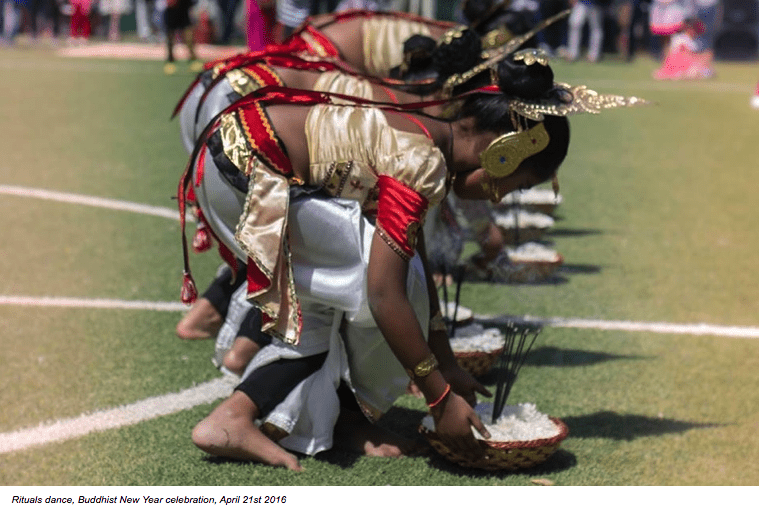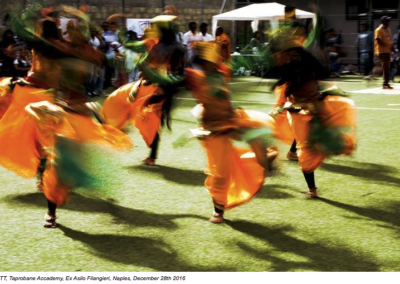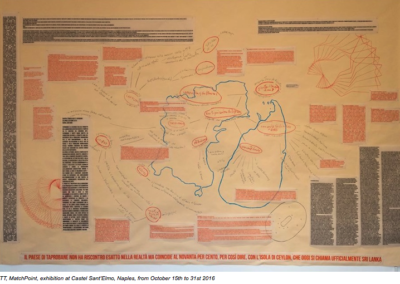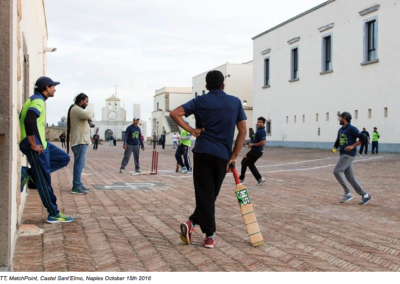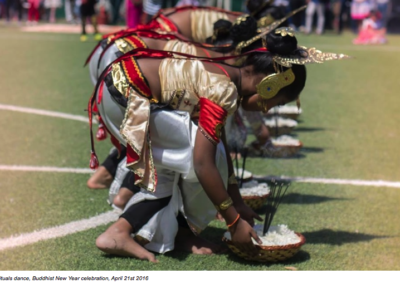As Richard Sennett writes, “doing good work means having curiosity about what is ambiguous, getting to the bottom of it and learning from ambiguity,” thus moving in a “border zone between problem solving and problem finding.” Curiosity and interest in what is unknown – even when, as in the case in question, we are talking about obvious but still poorly understood social processes – are the quintessence of Three Tigers-Taprobane, the project of the art collective Giusto il tempo di un tè, winner of the 2016 edition of the call for Art, Heritage and Human Rights, called by Connecting Culture.
The object of investigation is a social organism that, with its presence in the working-class neighborhoods of the city of Naples, actively protects its material and immaterial cultural heritage, both by revitalizing and maintaining entire city areas of pre-modern conformation, and by participating in the definition of the city effect (comparison, exchange, contamination). In fact, with more than ten thousand presences, Naples, after Milan, is the second province of destination of individuals of Sri Lankan origin (see Report on the Labour Market of Immigrants of the Ministry of Labour and Social Policies, 2012).
The Sri Lankan community is rooted in the areas of the historical center of Naples, activating exchanges with the resilient population but maintaining a strongly identified cultural structure. In particular, in the Rione Sanità and Montesanto, among the most popular, dense and multiethnic neighborhoods, it is possible to detect a significant presence, also found in small business activities that have a positive impact on the territory. The characteristic feature of this part of the metropolis is a peculiar form of dynamic coexistence, not stereotyped in the acceptance of a preordained model of coexistence. Here, the deeply rooted sense of territorial identity is open to critical confrontation with the neighbor, not identified with the stranger, even proxemically. The interaction between social groups and ethnic groups has developed following the organic rhythms of a dialectical process, the expression of a contiguity, possible also by virtue of the great industriousness that the community has demonstrated since the beginning of the 90’s, representing, in many cases, the new entrepreneurial segment of the neighborhoods in which they have settled.
Intervening in this scenario, the Tre Tigri-Taprobane project has proposed territorial laboratories of relationship between the Sri Lankan community, the population, the associations active on the territory and the institutions operating in the field of contemporary art, stimulating a peculiar hybridization between aesthetic, social and performative languages, in particular through cricket, national sport of Sri Lanka and, consequently, aggregative practice widespread among the streets of the city.
To this purpose, Sri Lankan associations were involved, such as the Kent Cricket Team, the dance school Nipuna Dance Academy and the webtv GeeTv, a reference point for the Sri Lankan community (geetvlive.blogspot.it). In addition, the various associations operating in the area, such as the Laboratorio Socioculturale Le Scalze, the Laboratorio di Architettura Nomade, L’Asilo Filangieri, Less Impresa Sociale and the Foundations active in the artistic and cultural sphere, such as the Fondazione Morra per le Arti Contemporanee and the Fondazione Donnaregina per le Arti Contemporanee, took an active part.
In this process, the definition of space proved to be the central element. Cricket is a sport that, intrinsically, aims to build a temporary field of relationship and by regulation it does not have a predefined measure of the playing area, prescribing only a formal dimension to be respected. Also as a consequence of these inputs, the processes of mutual acquaintance have been activated by the practice of hybridization between the respective geographies, crossing the trajectories through which the making of community develops, in a dialogical process continued from April 2016 to the present. Ultimately, a different option than the neo-liberal articulation of the “creative city” based on the paradigms of consumption and highly formalized creative supply chains (on this topic, I point out the studies of d’Ovidio and Cossu, who start precisely from the Milanese case of Macao).
Coming into contact with the various areas involved in the project, it was highlighted how the places that function as points of aggregation are those to which the administrators have given less defined functions, squares that become cricket fields, parks, “terrain vague” areas, such as the large space between the Poggioreale district and the Asse Mediano, which has become an immense Sunday cricket field. In the words of Franco La Cela: “social life takes shape precisely where the creativity of the inhabitants is not too constrained either by architecture or by norms”.
By gaining new concrete spaces for interaction, widening the relational possibilities from below, facilitating the permeability between places with an artistic vocation and spaces of social inclusion, Tre Tigri-Taprobane generated long-term operational opportunities for an urban mapping outlined by the overlap between topographical areas and the individuals and functions that cross them. This complex stratigraphy emerged, visually and narratively, in the scheme produced for MatchPoint, the meeting at Castel Sant’Elmo that was also part of the XII Giornata del Contemporaneo promoted by AMACI.
In this process of knowledge and narration, the subjects have also actively intervened in the identification of the places that hosted the workshops, chosen according to the intersections of urban geographies: from the spaces of the community – the Buddhist Temple – to those of the city’s vibrant self-organizational fabric – the Ex Asilo Filangieri – up to historical and institutional places, such as the Convent of San Nicola da Tolentino and Castel Sant’Elmo, whose Piazza d’Armi, for one day, was a cricket playing field, realizing an ideal symbolic gap and using the performance as a tool for the recognition of a common territory and social innovation. MatchPoint represented the common ground, on which identities were able to meet and integrate, connecting players, teams and cultures.
The practice of sports has provided a shared representative framework, interpreted by the languages of art, within which to return moments of cooperation and aggregation between institutions, associations, individuals and communities, subjects belonging to sectors rarely in contact. The entire process was intended as a relational laboratory “in fieri”, able to tend towards convergence between the various components of the urban fabric. The phases of MatchPoint have been documented and reworked in a short film, broadcasted exclusively by Exibart.tv and focused on the story of body expression as a coordinated movement, choreography of a collective ritual.
Currently, the project is continuing to further explore the dynamics of interaction present in the Sri Lankan community, addressing the carrom, another totem of the playful culture of the subcontinent and also widespread in Naples. Similar to cricket for the question of unpredictable trajectories, it is also centered on very similar rhythms and on a tension to the sharing of space, even if miniaturized on a domestic scale. Starting from this suggestion, “Carrom House” is at work, a meeting dedicated to the re-elaboration of carrom, through the proposal of a tournament to be played among the different subjects involved, who will contribute to draw up a specific regulation. Here https://vimeo.com/187235773 one of the stages of approach to the format, a meeting with Saman, the holder, recognized by the community, of the rules and practice of the game.
